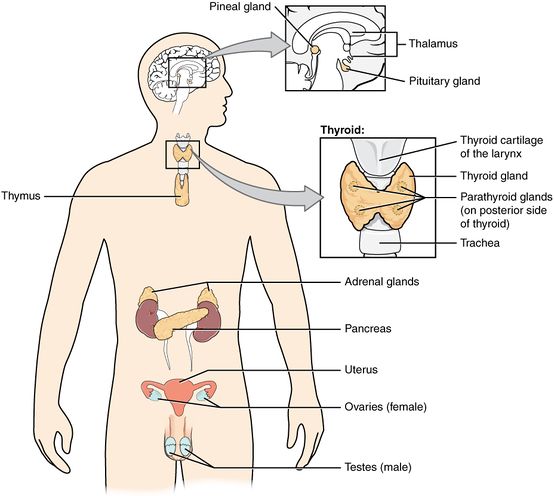Metabolic and Endocrine Disorders
Original Editor – Your name will be added here if you created the original content for this page.
Contents
The Endocrine System [ edit | edit source ]

The endocrine system works via chemical messengers (hormones) that are secreted directly into the circulatory system to regulate target organ function. The feedback loop works to control the release of these hormones and maintain homeostasis i.e the state of steady conditions vital for life. [1]
The diagram on the right shows the glands of the endocrine system ( Pineal gland, Thalamus, Pituitary gland,Thyroid, Adrenal glands, Pancreas, Uterus, Ovaries, Testes).
Glands of the Endocrine System [ edit | edit source ]
Each gland of the endocrine system releases specific hormones into the bloodstream. These hormones travel through circulatory system to other cells and help to coordinate body processes.
- Adrenal glands: Two glands that sit on top of the kidneys that release the hormone cortisol.
- Hypothalamus: A part of the lower middle brain that tells the pituitary gland when to release hormones.
- Ovaries: The female reproductive organs that release eggs and produce sex hormones.
- Islet cells in the pancreas: Cells in the pancreas control the release of the hormones insulin and glucagon.
- Parathyroid: Four tiny glands in the neck that play a role in bone development.
- Pineal gland: A gland found near the center of the brain that may be linked to sleep patterns.
- Pituitary gland: A gland found at the base of brain behind the sinuses. It is often called the “master gland” because it influences many other glands, especially the thyroid. Problems with the pituitary gland can affect bone growth, a woman’s menstrual cycles, and the release of breast milk.
- Testes: The male reproductive glands that produce sperm and sex hormones.
- Thymus: A gland in the upper chest that helps develop the body’s immune system early in life.
- Thyroid: A butterfly-shaped gland in the front of the neck that controls metabolism. [2]
Endocrine Disorders [ edit | edit source ]
A malfunction in the endocrine systems (either the glands, hormones, receptors or organs impacted by hormones) can cause an endocrine disorder. The various dysfunctions can cause wide-ranging effects on the body. The disorders arise from the effects caused by too little or too much secretion of a hormone or problems with receiving the hormone. [3] A metabolic disorder occurs when an improper level of a hormone alters the body’s metabolism and impacts its function (for example, diabetes). [4] [5]
Causes of Endocrine Disorders [ edit | edit source ]
Endocrine disorders are typically grouped into two categories:
- Endocrine disease that results when a gland produces too much or too little of an endocrine hormone, called a hormone imbalance.
- Endocrine disease due to the development of lesions (such as nodules or tumors) in the endocrine system, which may or may not affect hormone levels.
In a body that is functioning at optimum capacity the endocrine’s feedback system assists in controlling the balance of hormones in the bloodstream. The system can detect when a body has too much or too little of a certain hormone, the feedback system then sends signals to the appropriate gland(s) to regulate the discrepancy with a view of restoring homeostasis. If this equilibrium cannot be restored or maintained then a hormone imbalance may occur resulting and increase or decrease of hormone levels in the blood.
The most common causes of increased or decreased levels of endocrine hormones are:
- A problem with the endocrine feedback system
- Disease
- Failure of a gland to stimulate another gland to release hormones (for example, a problem with the hypothalamus can disrupt hormone production in the pituitary gland)
- A genetic disorder, such as multiple endocrine neoplasia (MEN) or congenital hypothyroidism
- Infection
- Injury to an endocrine gland
- Tumor of an endocrine gland – most endocrine tumors and nodules (lumps) are noncancerous. They usually do not spread to other parts of the body. However, a tumor or nodule on the gland may interfere with the gland’s hormone production. [2]
Causes of Endocrine Disorders [ edit | edit source ]
Endocrine disorders are typically grouped into two categories:
- Endocrine disease that results when a gland produces too much or too little of an endocrine hormone, called a hormone imbalance.
- Endocrine disease due to the development of lesions (such as nodules or tumors) in the endocrine system, which may or may not affect hormone levels.
The endocrine’s feedback system helps control the balance of hormones in the bloodstream. If your body has too much or too little of a certain hormone, the feedback system signals the proper gland or glands to correct the problem. A hormone imbalance may occur if this feedback system has trouble keeping the right level of hormones in the bloodstream, or if your body doesn’t clear them out of the bloodstream properly.
Increased or decreased levels of endocrine hormone may be caused by:
- A problem with the endocrine feedback system
- Disease
- Failure of a gland to stimulate another gland to release hormones (for example, a problem with the hypothalamus can disrupt hormone production in the pituitary gland)
- A genetic disorder, such as multiple endocrine neoplasia (MEN) or congenital hypothyroidism
- Infection
- Injury to an endocrine gland
- Tumor of an endocrine gland
Most endocrine tumors and nodules (lumps) are noncancerous. They usually do not spread to other parts of the body. However, a tumor or nodule on the gland may interfere with the gland’s hormone production.
Epidemiology [ edit | edit source ]
Endocrine disorders with U.S. prevalence estimates of at least 5% in adults included diabetes mellitus, impaired fasting glucose, impaired glucose tolerance, obesity, metabolic syndrome, osteoporosis, osteopenia, mild-moderate hypovitaminosis D, erectile dysfunction, dyslipidemia, and thyroiditis. Erectile dysfunction and osteopenia/osteoporosis had the highest incidence in males and females, respectively. The least prevalent conditions, affecting less than 1% of the U.S. population, were diabetes mellitus in children and pituitary adenoma. Conditions with the lowest incidence were adrenocortical carcinoma, pheochromocytoma, and pituitary adenomas. Certain disorders, such as hyperparathyroidism and thyroid disorders, were more common in females. As expected, the prevalence of diabetes mellitus was highest among ethnic minorities. [7]
Clinical Presentation [ edit | edit source ]
Due to the complex and interconnected nature of the endocrine system, a wide range of conditions with distinct clinical presentations, can result in endocrine disorders. including:
- Addison’s Disease
- Cushing’s Syndrome
- Diabetes
- Gout
- Hyperthyroidism
- Hypothyroidism
- Obesity
- Osteoporosis
- Paget’s Disease
- Estrogen dominance: changes in sleep patterns, changes in weight and appetite, higher perceived stress, slowed metabolism
- Polycystic Ovarian Syndrome (PCOS): infertility, weight gain, higher risk for diabetes, acne, abnormal hair growth
- Low estrogen: low sex drive, reproductive problems, menstrual irregularity, changes in mood .
- Low testosterone: erectile dysfunction, muscle loss, weight gain, fatigue, mood-related problems [8]
Endocrine Disruptors [ edit | edit source ]

Endocrine disruptors are chemicals that can interfere with endocrine systems at certain doses. These disruptions can cause cancerous tumors, birth defects, and other developmental disorders. Any system in the body controlled by hormones can be derailed by hormone disruptors. Specifically, endocrine disruptors may be associated with the development of learning disabilities, severe attention deficit disorder, cognitive and brain development problems deformations of the body that includes breast cancer, prostate cancer, thyroid and other cancers; sexual development problems such as feminizing of males or masculinizing effects on females, etc.[9]
There are some 800 chemicals suspected as being capable of interfering with hormone receptors, synthesis, conversion or cell signalling during critical periods of cell and organ development. Some of these occur naturally, but many are synthetic and used in agriculture (growth promoters, pesticides and wetting agents), plasticizers, as flame-retardants in textiles, clothing and furnishings, non-stick coatings, food additives, electronics and cosmetics, personal care products and perfumes.[10]
Diagnostic Testing [ edit | edit source ]
Due to the wide range of symptoms and conditions diagnosis can sometimes be difficult and where available, a referral to an endocrinologist may be made. In most cases blood and urine analysis will be carried out to determine hormone levels. If a nodule or a tumor is suspected imaging tests may be done to help locate and/or confirm any abnormalities. Due to the complex nature of hormones and their interactions a change in one hormone level can have a detrimental impact on another, which can affect diagnosis and treatment. [1] [9]
Management [ edit | edit source ]
Although management interventions and scope can vary depending on the type of disorder, physiotherapy can be beneficial for people with these conditions. Common goals are the management of pain to optimise function and mobility, patient education on the effects of the endocrine disorder on the body and how to maintain strength and fitness, energy conservation techniques and development of manageable and progressive exercise plans. [10] [11] [12] .
References [ edit | edit source ]
- ↑ 1.01.1 Melmed S, Polonsky KS, Larsen PR, Kronenberg HM. Williams textbook of endocrinology. Elsevier Health Sciences; 2015 Nov 30.
- ↑ 2.02.1 WebMD. Endocrine Disorders. Available from:https://www.webmd.com/diabetes/endocrine-system-disorders#1 (accessed 10/4/2019)
- ↑ Wikipedia. Endocrine system. Available from: https://en.wikipedia.org/wiki/Endocrine_system (last accessed 6.4.2019)
- ↑ Tampa general hospital. Endocrine disorders. Available from: https://www.tgh.org/services/diabetes-endocrinology/endocrine-disorder-causes (last accessed 7.4.2019)
- ↑ Lavin N. Manual of endocrinology and metabolism. Lippincott Williams & Wilkins; 2012 Mar 28.
- ↑ Krislynn314. Diseases and conditions of the endocrine system. Available from: https://www.youtube.com/watch?v=sz8_OGqu0sM (last accessed 7.4.2019)
- ↑ Golden SH, Robinson KA, Saldanha I, Anton B, Ladenson PW. Prevalence and incidence of endocrine and metabolic disorders in the United States: a comprehensive review. The Journal of Clinical Endocrinology & Metabolism. 2009 Jun 1;94(6):1853-78.
- ↑ Practo Can Physiotherapy Help Balancing Hormones? How It Helps PCOD? Available from:https://www.practo.com/healthfeed/can-physiotherapy-help-balancing-hormones-how-it-helps-pcod-32144/post (accessed 25.12.20200
- ↑ Colborn T. Neurodevelopment and endocrine disruption. Environmental health perspectives. 2003 Nov 17;112(9):944-9.
- ↑ August GP, Caprio S, Fennoy I, Freemark M, Kaufman FR, Lustig RH, Silverstein JH, Speiser PW, Styne DM, Montori VM. Prevention and treatment of pediatric obesity: an endocrine society clinical practice guideline based on expert opinion. The Journal of Clinical Endocrinology & Metabolism. 2008 Dec 1;93(12):4576-99.
- ↑ Jedel E, Labrie F, Odén A, Holm G, Nilsson L, Janson PO, Lind AK, Ohlsson C, Stener-Victorin E. Impact of electro-acupuncture and physical exercise on hyperandrogenism and oligo/amenorrhea in women with polycystic ovary syndrome: a randomized controlled trial. American Journal of Physiology-Endocrinology and Metabolism. 2010 Oct 13;300(1):E37-45.
- ↑ Bassuk SS, Manson JE. Epidemiological evidence for the role of physical activity in reducing risk of type 2 diabetes and cardiovascular disease. Journal of applied physiology. 2005 Sep;99(3):1193-204.